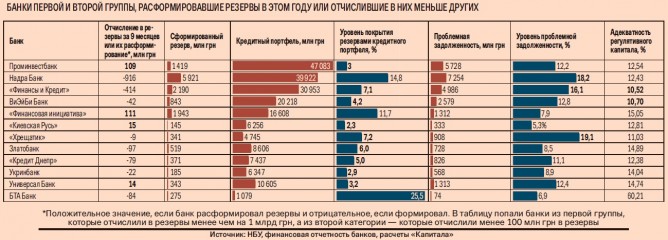Finance
banksBanks have no money to form adequate reserves

During the three quarters of the year Ukrainian banks deducted approximately UAH 54 bn to their reserves. This is three times more than over the same period last year. There are two reasons for such huge deductions. Devaluation of the national currency is the first reason – within nine months of the year the US dollar went up by 62%. This means that foreign exchange components in the balance sheets of the banks have increased automatically by the same amount. As a result, the banks had to form extra reserves for the previously issued currency loans. “Devaluation brings losses for banks because of the need to form extra reserves and the need to recapitalize,” says First Adviser to the Chairman of the Board of Alfa-Bank Roman Shpek.
The second reason – the borrowers are repaying their loans much worse. Every second loan in the ATO zone and the annexed Crimea is troubled. Payment discipline in the rest of Ukraine is deteriorating as well. Solvency of the population has declined and profits of businesses have dropped. Because of that every third loan in the system is repaid with problems. On account of deterioration of payment discipline consumer lending brings banks no profits these days, said Shpek. But those reserves that banks have already formed are insufficient.
Russian diddly squat
A third of the banks either formed very small reserves or even managed to break them during the first three quarters. Financial Initiative and Prominvestbank broke more reserves than others (UAH 111 mn and UAH 109 mn, respectively). The Financial Initiative could afford breaking the reserves because at the end of the quarter the coverage rate of the bank's loan portfolio was 12%, while Prominvestbank could not afford to take such a measure at all. The rate of reserve coverage of its loan portfolio amounted only to 3%. It is a very small indicator. In general, the acceptable level of the coverage ratio of the loan portfolio is close to 10%, says Director of the Study Center at the Baker Tilly auditing company Ruslan Ismailov. The higher the level of troubled debt, the more reserves should be formed. And the Prominvestbank’s “trouble” equals 12%. The press service of Prominvestbank did not say for which reason the financial institution broke its reserves in this case.
It is most likely that the reason is that formation of reserves would lead to a dramatic reduction of the bank’s regulatory capital. At the end of the third quarter the adequacy of regulatory capital at Prominvestbank was 12%, while the required minimum is 10%. Obviously, the bank will form reserves only after its owner Vnesheconombank invests money into it. Recently, Russian hackers published some materials from Vnesheconombank according to which Prominvestbank needs a minimum of UAH 6.2 bn. In case the bank does not get the required amount, Prominvestbank could go bankrupt in early 2015.
Leaky spoon
The Kyivska Rus Bank has an even lower level of coverage for loan reserves. During the three quarters of the year the bank broke UAH 15 mn in its reserves, which decreased the coverage ratio to 2%. “The bank restructured troubled credit, which helped repay some of it and liquidity support was provided. This resulted in a write-back of the reserve,” explained Director of the bank’s Risk Department Alla Prokopchuk.
Restructuring is one of the bankers’ favorite methods of understatement of the actual level of troubled loans. Prolonging the terms of payment of debts for borrowers that are late in repayments, financial institutions do not classify them as troubled and eventually the level of reserves turns out to be underestimated. In addition, such manipulations do not contradict the banking legislation. Formally, financial institutions comply with the requirements of the NBU.
The Ukrinbank also has a low level of reserve coverage – 2.9%. Such a low level of reservation was explained by good collateral. “Upon receipt of loans the bank lays down very stringent requirements to collateral. The coverage ratio of collateral at issue is on average at least 1:2, i.e. the value of collateral should be twice as much as the principal of the loan,” says Deputy Director of the Corporate Business Department at Ukrinbank Viktoria Bicheva. She added that currently the bank had UAH 2.7 bn worth of real estate and UAH 14.3 worth of rights and deposits in collateral. “Collateral is several times higher than the current loan portfolio,” says Bicheva. Yet the banks have problems with good collateral these days. In particular, the Verkhovna Rada prohibited repossessing mortgaged apartments from the population. In addition, the bankers often complain of difficulties arising when they try to take collaterals from corporate borrowers.
Universal Bank has a slightly higher rate of reserves – 3.2%. This disproves the myth that all banks with European capital form reserves on time and in full. The low level of reserves allows financial institutions to maintain an acceptable level of capital adequacy – 14.74%. “The bank plans to increase reserves in the fourth quarter,” says Chief of the bank’s Marketing and Communications Department Halyna Yakushchenko. Obviously, the bank's plans for the last quarter are related to the capital increase – on November 3 the general meeting of shareholders of Universal Bank decided to increase the authorized capital by UAH 500 mn. The money for additional capitalization will be allocated by the bank’s Greek parent company Eurobank Group. It is most likely that all the funds will be used for reserves and at year-end the bank will register a loss.







 of the agreement of syndication with Financial Times Limited are strictly prohibited. Use of materials which refers to France-Presse, Reuters, Interfax-Ukraine, Ukrainian News, UNIAN agencies is strictly prohibited. Materials marked
of the agreement of syndication with Financial Times Limited are strictly prohibited. Use of materials which refers to France-Presse, Reuters, Interfax-Ukraine, Ukrainian News, UNIAN agencies is strictly prohibited. Materials marked  are published as advertisements.
are published as advertisements.